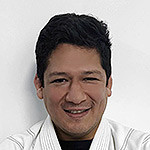The impediment to action advances action. what stands in the way becomes the way.
Why is Brazilian Jiu Jitsu So Difficult?
The Jiu Jitsu paradox is one that impacts a person’s life in a positive and meaningful way but can be very challenging and (at times) demoralizing in practice. The practice of Jiu Jitsu simulates life’s adversity and triumph in a controlled environment allowing the student many chances to rehearse their response to these outcomes and grow stronger with each small success. So why is the drop-out rate for beginner students so high in Brazilian Jiu Jitsu?
The BJJ Training Paradigm in NYC
The sport mindset The BJJ scene in NYC is quite spectacular. World champions and famous instructors located in all corners of our little island of Manhattan. However, the practice of BJJ here in NYC tend to follow a more competition-oriented model. Success is measured based on competition results. Whether for medals or praise from the BJJ Coach, the constant yearning to win compromises the opportunity to delve deep into, and experiment with, newly learned techniques. Competitive pressure is introduced to the new student prematurely resulting in high rates of injury and loss of confidence. Naturally, it becomes a scenario of only the strong remain. Lack of learning structure is another obstacle faced by the new student. It is not uncommon to train at a BJJ Academy where the path to mastery of the many techniques and concepts is vague. Because of the sport mindset approach, achievement is often rewarded primarily based on competition success – the ability to tap the other person out.
Gracie Jiu Jitsu® - Master Cycle Program
Gracie University established the Master Cycle® program for practitioners, that want to go beyond the self-defense aspect of Gracie Combatives®, and learn the Art of Jiu Jitsu in its complete form. It is a program that provides a nurturing environment for new practitioners while teaching the concepts needed to achieve Mastery in the practice of Jiu Jitsu.
Safety first
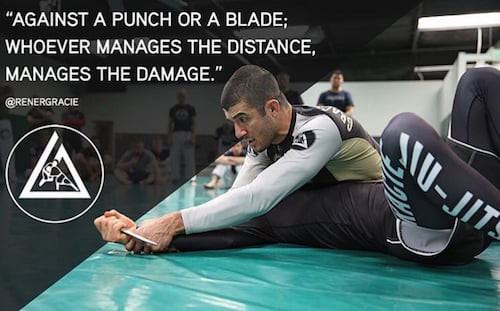
Today, injuries tend to occur most often for beginners due to non-familiarity with the techniques and mismanagement of energy and intensity levels during training. A competitive mindset in contrast to a more cooperative learning mindset, changes the context of the students training objective.
Gracie Jiu Jitsu practitioners focus on deeper understanding of the techniques, and its efficient application, and less about submitting his/her classmate. Thus, appreciation in how the technique was applied to get the submission is focused on, rather than just forcing the submission. This training mentality ensures a safer training session, allowing the student to train effectively while avoiding disruptive injuries.
Structure determines success.
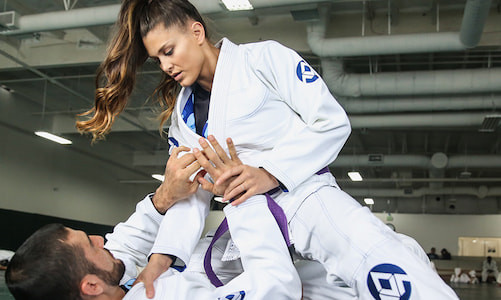
If the framework to achieve success is wrong, no amount of hard work can get you to your goal. The Master Cycle curriculum is the framework to learning the hundreds of techniques in Gracie Jiu Jitsu. It provides an organized approach by grouping techniques into 7 positional chapters so that it is compartmentalized and easily remembered.
The 7 Positional chapters.
Gracie Jiu Jitsu identifies 7 root positions where the student may potentially find themselves. The techniques within the chapter are further categorized into a sub-section (i.e. Escape from the Mount (1), controls from the Guard (3) or Front-Attack Defense from the Standing (7), positions.) Within this positional matrix, there are hundreds of possible combinations of Jiu Jitsu techniques. The goal of the Master Cycle is to take the students through each phase in order to mentally retrieve and apply this matrix and its technical combinations proficiently during live rolling sessions (sparring). Once they have this foundation, is when they can begin to express their unique individual approach to Jiu Jitsu. Like playing the piano, where each of the boxes (table below) is a key. It’s only when you master each key and some basic musical combinations can you begin to add your personal flare.
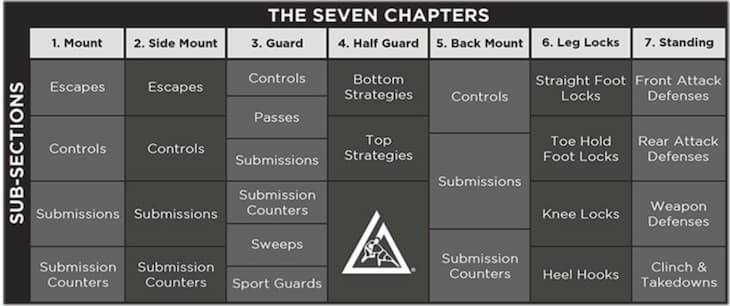
Linear Approach – the most efficient means of progression
The 7 positional chapters are accompanied by their sub-section of techniques grouped together for each student’s level of competency. Blue belts testing for their first strip would not be required to learn the more advanced techniques like ‘The Twister.’ Thereby allowing the student to focus only on the techniques that he/she can move onto based on their previous achievement.
Gi, No-Gi and Fight Simulation.
Gi Training. Training with a Gi is an essential training tool of Gracie Jiu Jitsu. It enhances the student’s technical abilities. Because there are so many ‘grips’ on a Gi, it forces the sparring practice to rely more on techniques rather than athleticism to escape or submit your training partner. From a self-defense standpoint training with a Gi also ensures familiarity should the students clothing every be used against them in a real altercation. No-Gi Training. No-Gi Training or submission grappling is a supplemental component to training. With less ‘grips,’ Athleticism is introduced, and the speed of the sparring session is increased greatly. No-Gi training is also an important part of development, as it forces the student to find new ways to apply their GJJ techniques without the assistance of a Gi. Fight Simulation (FS). Gracie Jiu Jitsu is unique in that we incorporate a dedicated class to Fight Simulation. The student wears protective 4oz fingerless gloves and incorporate striking into the drills and live rolling session. The purpose to this practice is to simulate an actual fight where the Jiu Jitsu student must defend against a striking opponent. Fight simulation is practiced and tested at every stripe and belt level.
Ranking System
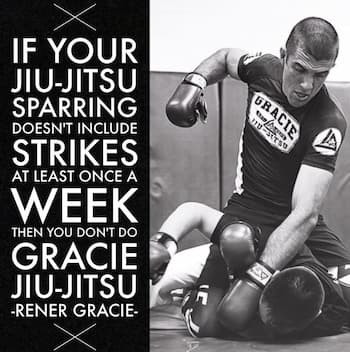
The color belt ranking system follows that of the rest of the BJJ community: White, Blue, Purple, Brown and Black. However, the Gracie Jiu Jitsu ranking requirements greatly differ. Because Gracie Jiu Jitsu differs (philosophically) from other academies with sport-centric objectives, Gracie Jiu Jitsu’s rank requirements are rooted in practical applicability of Jiu Jitsu techniques. Their overarching question is always - does it work in a real fight? Proficiency in the complete curriculum is necessary in Gracie Jiu Jitsu.
Sport-centric academies, evaluate their students based only on results – did he/she get the submission? And not so much, on how the student got to the submission or whether the student understands the concepts of each position and their applicable techniques. Learning Gracie Jiu Jitsu is about calibrating your mindset towards training, learning the complete system and its principles - not just the singular techniques that gets the win in competition.
Testing
The testing process is observed through attendance and a formal evaluation of proficiency in applying the Gracie Jiu Jitsu techniques and principles taught in each lesson. Blue belt to Purple belt progression example. In order to move from Blue to Purple belt the student will be evaluated on his/her proficiency for each of the 60 unique lessons needed to be awarded a stripe. 4 stripes are required to qualify to test for Purple belt. By the time the student is ready to test for Purple Belt, he/she should have 240 learned techniques to be evaluated on.
This Certified Gracie Jiu-Jitsu Training Center is independently owned and operated. Gracie Jiu-Jitsu®, Gracie Combatives®, Gracie Bullyproof®, Women Empowered®, and Certified Gracie Jiu-Jitsu Training Center®, are registered trademarks used under license from Gracie University.


